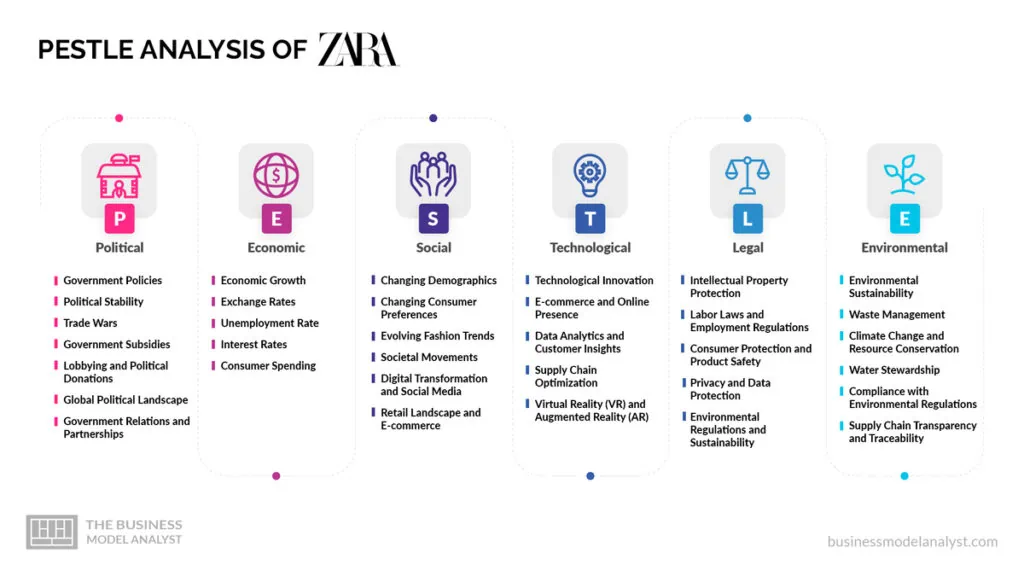A comprehensive Zara PESTLE analysis will provide valuable insights into the external factors that shape the company’s strategies, market position, and overall business performance.
Zara, a renowned global fashion retailer, has enjoyed immense success and popularity in the competitive fashion industry. However, like any other business, it is not immune to the forces of the external environment. This article will identify the key political, economic, social, technological, legal, and environmental factors that could impact the company’s future.
The PESTLE analysis is a strategic tool that helps businesses understand and manage risks and opportunities. By examining the external environment, companies can make informed decisions about allocating resources and positioning themselves for future growth. This analysis will delve into the factors that shape Zara’s operations, market presence, and overall business performance.
Understanding these factors can enable Zara to navigate challenges and capitalize on opportunities in an ever-changing fashion industry.
Contents
Zara Political Factors

Zara is susceptible to political factors significantly impacting its business operations and performance. These political factors include:
- Government Policies: Government policies have a direct influence on Zara’s business. Changes in tax laws can affect the company’s profitability, while new regulations may impose restrictions that hinder its operations. Zara needs to closely monitor government policies in its operating countries to adapt to any changes that could impact its business.
- Political Stability: Political stability is crucial for Zara’s operations. Instability in a country where Zara operates can lead to disruptions in its supply chain or even the closure of its stores. The company has to assess the political climate in its operating countries to mitigate the risk of political unrest.
- Trade Wars: Trade wars between countries can also impact Zara’s business. Tariffs or trade restrictions on its products can make them more expensive and less competitive. Zara needs to closely monitor trade relations between countries to anticipate and mitigate any potential trade wars that could threaten its business.
- Government Subsidies: The presence of government subsidies for competitors can give them an unfair advantage over Zara. If a government subsidizes the production of garments by a competitor, it may offer its products at a more affordable and competitive price. Zara needs to be aware of such subsidies to ensure it remains competitive.
- Lobbying and Political Donations: Like other multinational corporations, Zara may engage in lobbying and political donations to influence policies that directly impact its business. These activities can help shape favorable regulations and create a conducive business environment for the company.
- Global Political Landscape: Changes in the global political landscape, such as the rise of protectionism or nationalist movements, can have far-reaching effects on Zara’s business. The company needs to monitor global political trends closely to anticipate any potential impact on its supply chain, market access, or consumer behavior.
- Government Relations and Partnerships: Zara can benefit from building strong relationships with governments and establishing partnerships. Collaborating with governments on sustainability, labor practices, or social responsibility initiatives can enhance the company’s reputation and foster a positive image among consumers and stakeholders.
- Intellectual Property Protection: Changes in intellectual property laws can challenge Zara’s ability to protect its designs and trademarks. Strong intellectual property rights protection is vital to prevent counterfeiting and unauthorized use of its designs.
- Political Boycotts: There is also the potential for political boycotts of Zara’s products in certain countries. Political factors such as geopolitical conflicts or ideological differences may lead to consumer boycotts that can impact the company’s sales and brand reputation.
Zara Economic Factors
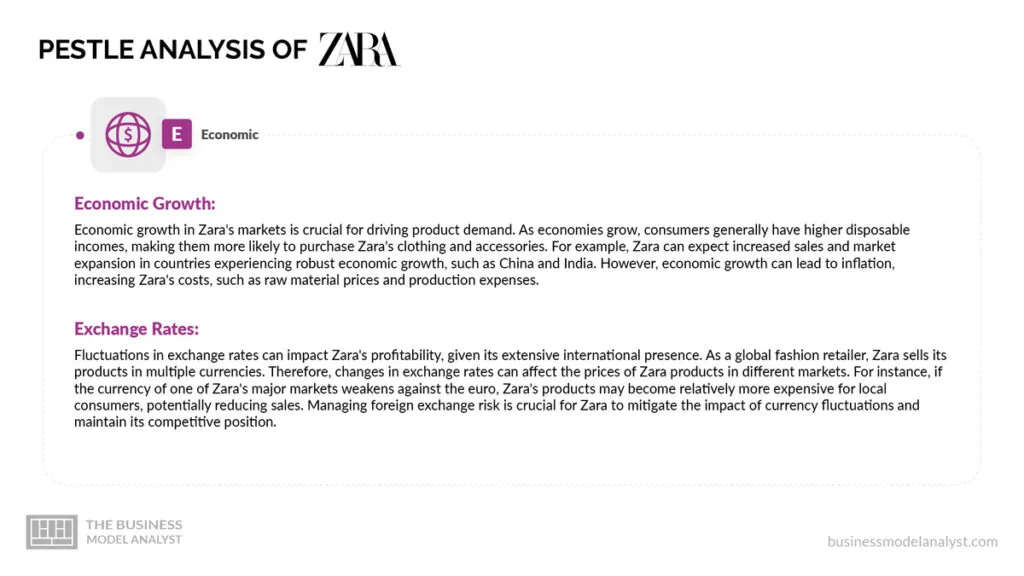
Economic factors play a significant role in influencing Zara’s business operations. Here are some of the economic factors that can impact Zara’s business:
- Economic Growth: Economic growth in Zara’s markets is crucial for driving product demand. As economies grow, consumers generally have higher disposable incomes, making them more likely to purchase Zara’s clothing and accessories. For example, Zara can expect increased sales and market expansion in countries experiencing robust economic growth, such as China and India. However, economic growth can lead to inflation, increasing Zara’s costs, such as raw material prices and production expenses.
- Exchange Rates: Fluctuations in exchange rates can impact Zara’s profitability, given its extensive international presence. As a global fashion retailer, Zara sells its products in multiple currencies. Therefore, changes in exchange rates can affect the prices of Zara products in different markets. For instance, if the currency of one of Zara’s major markets weakens against the euro, Zara’s products may become relatively more expensive for local consumers, potentially reducing sales. Managing foreign exchange risk is crucial for Zara to mitigate the impact of currency fluctuations and maintain its competitive position.
- Unemployment Rate: Zara’s sales are influenced by the unemployment rate in its operating regions. A lower unemployment rate indicates a higher population with stable incomes, making them potential customers for Zara’s fashion offerings. Conversely, higher unemployment rates can limit consumer spending power and reduce demand for non-essential items like clothing. For example, during economic downturns, Zara may experience a decline in sales as consumers prioritize essential items over fashion purchases. Monitoring the unemployment rate in key markets is necessary for Zara to adjust its strategies and offerings accordingly.
- Interest Rates: Changes in interest rates can have implications for Zara’s financial operations. As a company operating internationally, Zara may rely on borrowing to finance its operations, such as expanding its stores or investing in technology. Fluctuations in interest rates can impact the cost of borrowing, potentially affecting Zara’s profitability. Higher interest rates can increase Zara’s borrowing costs, reducing its financial flexibility and limiting its investment ability. Therefore, Zara needs to closely track interest rate movements and consider them in its financial planning and decision-making processes.
- Consumer Spending: Consumer spending is a key driver of economic growth, and Zara’s sales heavily rely on consumer behavior. In periods of robust consumer spending, Zara can expect increased demand for its fashion products. However, any slowdown in consumer spending can adversely affect Zara’s performance. For example, during economic recessions or uncertainty, consumers may reduce their discretionary spending, impacting Zara’s sales and revenue. Understanding consumer spending patterns and adjusting its marketing and product strategies accordingly is crucial for Zara to maintain its competitive edge in the fashion industry.
In addition to these economic factors, Zara should be aware of several other aspects that could impact its business. These include economic forecasting to anticipate market trends, the risks associated with volatile economies in specific markets, opportunities from new economic policies promoting innovation and free trade, and government spending changes that may affect consumer demand for fashion products.
Moreover, Zara should stay vigilant about potential economic recessions that could significantly impact its business operations and adjust its strategies accordingly to mitigate risks and capitalize on emerging opportunities.
Zara Social Factors
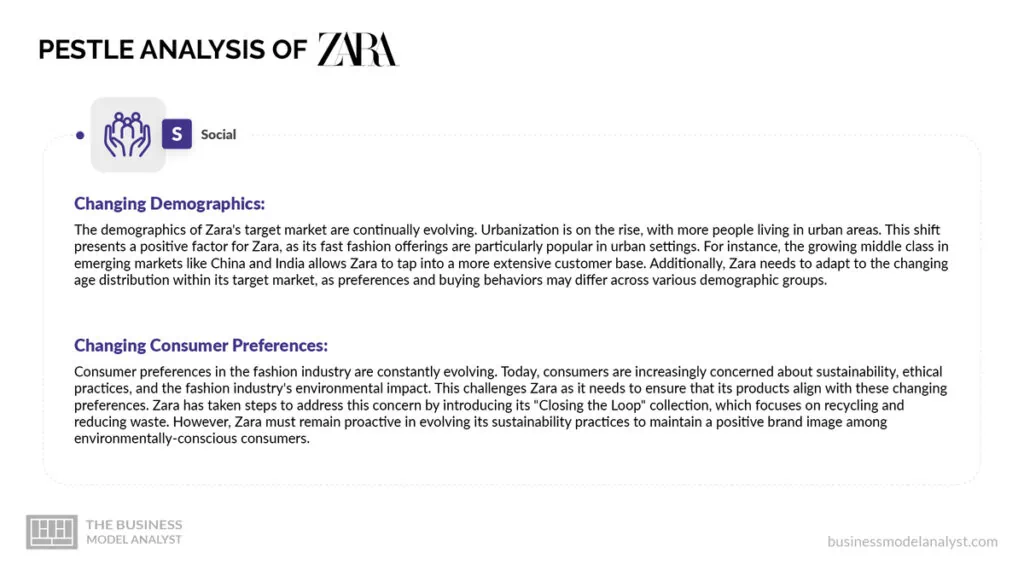
Several social factors profoundly impact Zara’s business operations and strategies. These factors encompass changing demographics, shifting consumer preferences, evolving fashion trends, and societal movements.
- Changing Demographics: The demographics of Zara’s target market are continually evolving. Urbanization is on the rise, with more people living in urban areas. This shift presents a positive factor for Zara, as its fast fashion offerings are particularly popular in urban settings. For instance, the growing middle class in emerging markets like China and India allows Zara to tap into a more extensive customer base. Additionally, Zara needs to adapt to the changing age distribution within its target market, as preferences and buying behaviors may differ across various demographic groups.
- Changing Consumer Preferences: Consumer preferences in the fashion industry are constantly evolving. Today, consumers are increasingly concerned about sustainability, ethical practices, and the fashion industry’s environmental impact. This challenges Zara as it needs to ensure that its products align with these changing preferences. Zara has taken steps to address this concern by introducing its “Closing the Loop” collection, which focuses on recycling and reducing waste. However, Zara must remain proactive in evolving its sustainability practices to maintain a positive brand image among environmentally-conscious consumers.
- Evolving Fashion Trends: Fashion trends are continually changing, driven by celebrity culture, social media influencers, and global events. Zara’s ability to stay on top of these trends and quickly adapt its product offerings is crucial for its success. Zara’s fast fashion business model allows it to swiftly respond to emerging trends and bring them to the market in a short time frame. By analyzing consumer behavior and monitoring fashion influencers, Zara can ensure that its product lines resonate with current fashion trends.
- Societal Movements: Zara needs to be attuned to societal movements that can influence consumer behavior and brand perception. For example, social movements promoting inclusivity, diversity, and body positivity have gained significant traction recently. Zara should consider aligning its brand values and marketing efforts with these movements to strengthen its connection with consumers. Additionally, the rise of conscious consumerism, where individuals prioritize purchasing from brands that align with their values, necessitates that Zara emphasizes its commitment to social responsibility and ethical practices.
- Digital Transformation and Social Media: The increasing use of social media platforms and digital technologies has transformed how consumers engage with fashion brands. Zara must embrace digital transformation and leverage social media to enhance its brand visibility and engage with its target audience. Zara can build a solid online community and develop a loyal customer base by actively participating in conversations and interactions on social media platforms. Moreover, Zara can utilize social media listening tools to gather insights and understand consumer preferences and sentiments.
- Retail Landscape and E-commerce: The retail industry is experiencing a shift towards e-commerce and online shopping. Zara needs to adapt its retail strategies to cater to the preferences of digitally savvy consumers. Investing in its e-commerce platform, providing a seamless online shopping experience, and offering convenient delivery options are crucial for Zara’s success in the evolving retail landscape. Additionally, Zara should consider integrating its online and offline channels to create a seamless omnichannel customer experience.
Zara’s ability to adapt to these social factors and align its strategies with changing customer preferences and societal movements will be vital to maintaining its competitive edge in the fast fashion industry.
Zara Technological Factors
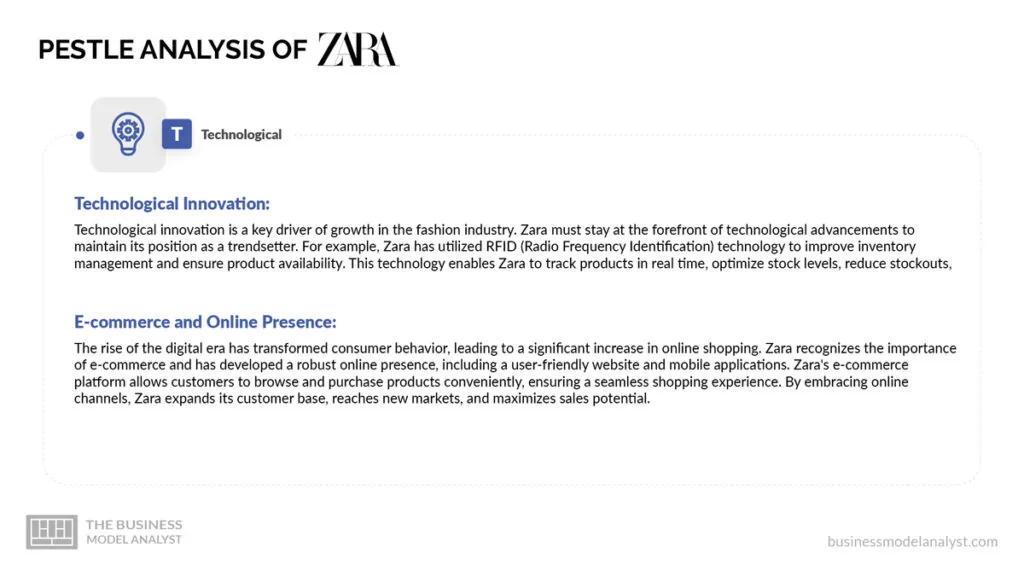
Technological factors are crucial for Zara’s success in the fast-paced fashion industry. As a leading global fashion retailer, Zara must continuously adapt and leverage technology to stay competitive, streamline operations, and meet changing customer demands. The following technological factors greatly influence Zara’s business strategy and operations:
- Technological Innovation: Technological innovation is a key driver of growth in the fashion industry. Zara must stay at the forefront of technological advancements to maintain its position as a trendsetter. For example, Zara has utilized RFID (Radio Frequency Identification) technology to improve inventory management and ensure product availability. This technology enables Zara to track products in real time, optimize stock levels, reduce stockouts, and enhance overall supply chain efficiency.
- E-commerce and Online Presence: The rise of the digital era has transformed consumer behavior, leading to a significant increase in online shopping. Zara recognizes the importance of e-commerce and has developed a robust online presence, including a user-friendly website and mobile applications. Zara’s e-commerce platform allows customers to browse and purchase products conveniently, ensuring a seamless shopping experience. By embracing online channels, Zara expands its customer base, reaches new markets, and maximizes sales potential.
- Data Analytics and Customer Insights: Data analytics plays a crucial role in understanding customer preferences and trends. Zara utilizes data analytics to gain valuable insights into consumer behavior, enabling personalized marketing campaigns and targeted product development. By analyzing data from various sources, including sales trends and social media interactions, Zara can tailor its collections to meet customer demands, ensuring high customer satisfaction and loyalty.
- Supply Chain Optimization: Zara’s success is built on a unique and efficient supply chain model. Technological advancements, such as digital communication and automation, optimize Zara’s supply chain operations. The company utilizes advanced software and systems to communicate with suppliers and track production processes in real time. This real-time visibility allows Zara to respond quickly to changes in demand and supply, reducing lead times and enabling a fast-fashion approach.
- Virtual Reality (VR) and Augmented Reality (AR): Integrating VR and AR technologies offers exciting opportunities for enhancing the customer shopping experience. By implementing VR and AR features, Zara can provide customers with virtual try-on options, allowing them to visualize how different clothing items would look on them. This interactive and immersive experience enhances customer engagement and reduces the likelihood of returns, boosting overall customer satisfaction.
- Sustainability and Eco-Innovations: Technological advancements also play a crucial role in Zara’s sustainability efforts. The company invests in eco-innovations and sustainable practices, such as adopting more environmentally friendly materials and manufacturing processes. Technological innovations enable Zara to explore new ways to reduce waste, minimize its carbon footprint, and create more sustainable fashion solutions.
- Artificial Intelligence (AI) and Machine Learning: AI technologies offer significant potential for Zara in various areas, including demand forecasting, inventory management, and personalized marketing. By analyzing historical data and consumer behavior patterns, Zara can optimize inventory levels, reduce overstocking or stockouts, and deliver a customized shopping experience. AI-driven algorithms can also help Zara predict future fashion trends and tailor collections accordingly.
Zara Legislative Factors
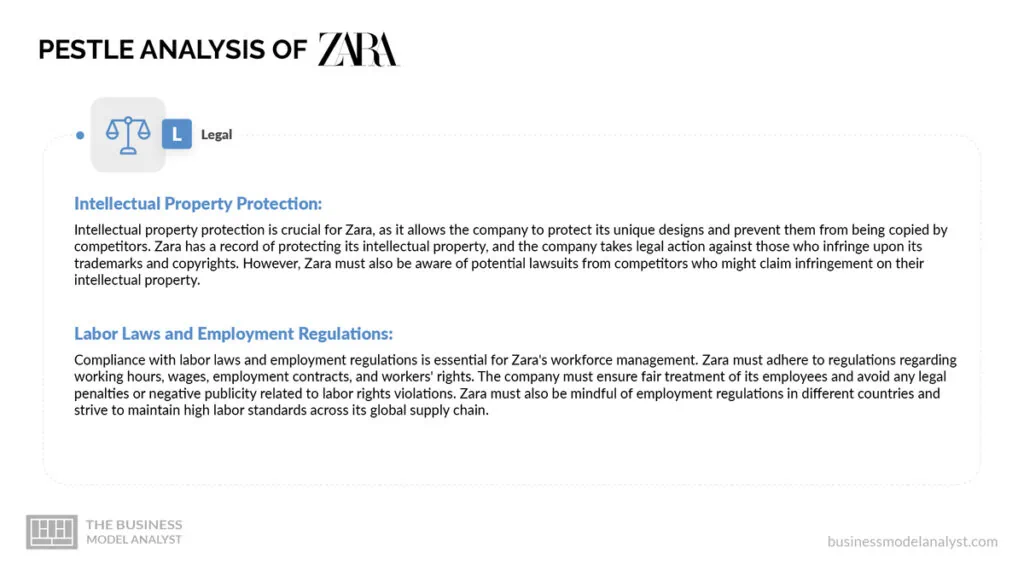
Legislative factors heavily influence Zara’s business operations, as the company operates in multiple countries worldwide. The following are some of the key legal factors that can impact Zara’s business:
- Intellectual Property Protection: Intellectual property protection is crucial for Zara, as it allows the company to protect its unique designs and prevent them from being copied by competitors. Zara has a record of protecting its intellectual property, and the company takes legal action against those who infringe upon its trademarks and copyrights. However, Zara must also be aware of potential lawsuits from competitors who might claim infringement on their intellectual property.
- Labor Laws and Employment Regulations: Compliance with labor laws and employment regulations is essential for Zara’s workforce management. Zara must adhere to regulations regarding working hours, wages, employment contracts, and workers’ rights. The company must ensure fair treatment of its employees and avoid any legal penalties or negative publicity related to labor rights violations. Zara must also be mindful of employment regulations in different countries and strive to maintain high labor standards across its global supply chain.
- Consumer Protection and Product Safety: Zara must comply with consumer protection laws and regulations to ensure the safety and quality of its products. This includes adhering to standards such as the European Union’s General Product Safety Directive, which sets product safety and quality requirements. Zara must also closely monitor its supply chain to ensure that no hazardous or counterfeit products enter the market, which could result in legal liabilities and harm the company’s reputation.
- Privacy and Data Protection: With the growing digital landscape, Zara needs to comply with privacy and data protection laws in its operating countries. This includes regulations like the European Union’s General Data Protection Regulation (GDPR), which sets strict rules on collecting, storing, and processing customers’ personal data. Zara must ensure that it obtains proper consent from its customers and takes necessary measures to protect their data to avoid legal complications and maintain their trust.
- Environmental Regulations and Sustainability: Zara must also navigate environmental regulations and promote sustainable practices. The company needs to comply with laws regarding waste management, emissions, and sustainable sourcing. Zara’s commitment to sustainability is evident through its efforts to reduce its carbon footprint, optimize resource usage, and use eco-friendly materials in its products. Adhering to environmental regulations helps Zara meet legal requirements and contributes to building a positive brand image.
- Trade Regulations and Customs Compliance: Zara operates in a global market and must adhere to international trade regulations and customs requirements. The company must navigate complex import and export regulations, tariffs, and trade agreements between countries. Compliance with these regulations ensures smooth operations and avoids shipment delays, customs duties, and potential trade disputes.
Zara Environmental Factors
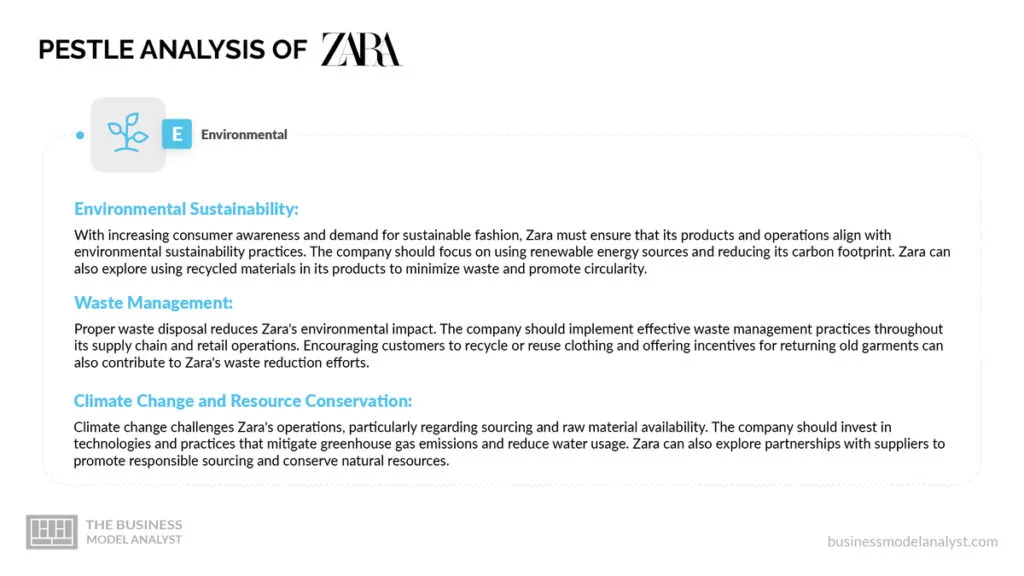
Environmental sustainability has become a significant factor for Zara as consumer demand for environmentally friendly and sustainable products continues to rise. The company recognizes the importance of addressing environmental concerns and implementing sustainable initiatives. The following environmental factors are particularly relevant to Zara:
- Environmental Sustainability: With increasing consumer awareness and demand for sustainable fashion, Zara must ensure that its products and operations align with environmental sustainability practices. The company should focus on using renewable energy sources and reducing its carbon footprint. Zara can also explore using recycled materials in its products to minimize waste and promote circularity.
- Waste Management: Proper waste disposal reduces Zara’s environmental impact. The company should implement effective waste management practices throughout its supply chain and retail operations. Encouraging customers to recycle or reuse clothing and offering incentives for returning old garments can also contribute to Zara’s waste reduction efforts.
- Climate Change and Resource Conservation: Climate change challenges Zara’s operations, particularly regarding sourcing and raw material availability. The company should invest in technologies and practices that mitigate greenhouse gas emissions and reduce water usage. Zara can also explore partnerships with suppliers to promote responsible sourcing and conserve natural resources.
- Water Stewardship: As water scarcity becomes a growing concern, Zara should prioritize responsible water management within its supply chain. By implementing water-saving technologies and collaborating with suppliers to improve water usage efficiency, Zara can minimize its water footprint and support sustainable water stewardship practices.
- Compliance with Environmental Regulations: Zara needs to ensure compliance with environmental regulations in its operating countries. By going beyond minimum requirements and maintaining environmental management systems, the company can demonstrate its commitment to environmental best practices.
- Supply Chain Transparency and Traceability: Zara should emphasize supply chain transparency and traceability to ensure responsible sourcing practices. By collaborating with suppliers to improve visibility into their operations and identify potential environmental risks, Zara can make informed decisions and address sustainability issues within its supply chain.
- Consumer Education and Awareness: Zara should prioritize consumer education and awareness initiatives to inform customers about its environmental sustainability efforts. By sharing transparent information about its sustainable practices and initiatives, Zara can build trust with eco-conscious consumers and enhance brand loyalty.
Conclusion
The PESTLE analysis on Zara highlights the external factors that could influence the company’s performance. Zara’s ability to adapt to changing political, economic, social, technological, legal, and environmental trends has been key to its success.
However, challenges such as political instability, economic fluctuations, evolving consumer behavior, rapid technological advancements, changing regulations, and sustainability issues can impact Zara’s operations.
By monitoring these factors and implementing strategic initiatives to mitigate risks and leverage opportunities, Zara can continue to thrive in the fast-paced fashion industry.


